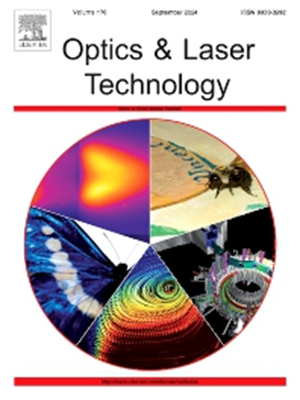A porosity prediction method for laser cladding with imbalanced multi-modal data
IF 4.6
2区 物理与天体物理
Q1 OPTICS
引用次数: 0
Abstract
Porosity is one of the most important defects in laser cladding (LC); therefore, the prediction of porosity during LC is crucial. Recently, the prediction process has been conducted on images or temperatures from only the melt pool, which hinders the prediction performance due to the incomplete characterization of defects from single-modal data. Multi-modal methods can combine images and temperature fields to provide a more complete characterization of porosity defects, but this approach is limited by data imbalance and data interaction. In this study, a novel multi-modal imbalanced data prediction network (MIDPN), which contains a data mapping module, a feature extraction module and a feature interaction module, is proposed to address these issues. For data imbalance, the data mapping module of the MIDPN uses an improved generative adversarial network that maps image data to the temperature field, with the purpose of generating missing temperature field data to resolve data imbalance. In the feature extraction module, convolutional neural networks are utilized to extract the image feature and temperature field feature of the melt pool. For data interaction, the MIDPN establishes a guided attention mechanism for image-temperature field features to facilitate the interaction of features from both modalities and utilizes the fully connected layers to obtain porosity prediction results. The experimental results show that the proposed method achieves an accuracy of 96% in predicting porosity, which is better than those of the other methods. Overall, this study significantly improved the reliability of porosity prediction, enabling more accurate quality assessment for LC monitoring, and promoting proactive defect prevention.
求助全文
约1分钟内获得全文
求助全文
来源期刊
CiteScore
8.50
自引率
10.00%
发文量
1060
审稿时长
3.4 months
期刊介绍:
Optics & Laser Technology aims to provide a vehicle for the publication of a broad range of high quality research and review papers in those fields of scientific and engineering research appertaining to the development and application of the technology of optics and lasers. Papers describing original work in these areas are submitted to rigorous refereeing prior to acceptance for publication.
The scope of Optics & Laser Technology encompasses, but is not restricted to, the following areas:
•development in all types of lasers
•developments in optoelectronic devices and photonics
•developments in new photonics and optical concepts
•developments in conventional optics, optical instruments and components
•techniques of optical metrology, including interferometry and optical fibre sensors
•LIDAR and other non-contact optical measurement techniques, including optical methods in heat and fluid flow
•applications of lasers to materials processing, optical NDT display (including holography) and optical communication
•research and development in the field of laser safety including studies of hazards resulting from the applications of lasers (laser safety, hazards of laser fume)
•developments in optical computing and optical information processing
•developments in new optical materials
•developments in new optical characterization methods and techniques
•developments in quantum optics
•developments in light assisted micro and nanofabrication methods and techniques
•developments in nanophotonics and biophotonics
•developments in imaging processing and systems

 求助内容:
求助内容: 应助结果提醒方式:
应助结果提醒方式:


